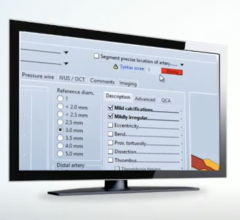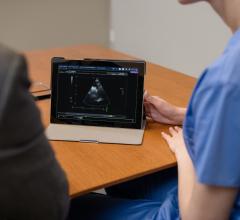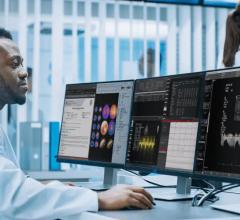
The Philips IntelliSpace is an example of the newer generation of cardiovascular information systems (CVIS) that can consolidate all cardiology department data sources into one location.
Consolidation of data in one location to improve efficiency and enable data analytics, as well as smooth integration with enterprise electronic medical record (EMR) systems are the two main priorities for most hospitals today looking for a new cardiovascular information system (CVIS). CVIS vendors worked over the past several years to create truly vendor-neutral systems that enable a single point of access to patient information from different sources. The newer systems can quickly retrieve a patient's complete cardiology file, generate a report and distribute it, all during one session, even from a remote location. Images, reports and relevant, sophisticated toolkits also are supported by new task-based clinical workflows now offered by many CVIS.
Adopting Cardiac Specialty Reporting Systems Outside the EMR
While most hospital systems are migrating to large, all-encompassing EMRs, the cardiology reporting modules offered by these EMR vendors often lack the depth in reporting that long-time CVIS vendors can offer. Epic has captured a growing share of the EMR market and is billed as a one-stop shop for all of a hospital’s information technology needs. However, complaints from various subspecialties including cardiology, radiology, oncology, orthopedics, etc., have been that the Epic specialty reporting modules lack depth, or are missing needed reporting parameters, or do not offer device connectivity to imaging modalities, patient testing or monitoring systems. This can include data integration with electrophysiology (EP) mapping and recording systems, or cath lab hemodynamic systems.
So, while large EMR companies like Epic, Cerner, Allscripts and others have many hospitals using their systems, many cardiology and radiology departments have been successful in maintaining their own specialty reporting systems. However, as health information technology (IT) departments become more deeply involved in all clinical aspects of healthcare operations and gain more oversight on decisions of what software systems are purchased, the need for deep interoperability with the EMR is usually a deciding factor.
This need to play nice with big EMR vendors has led to a change in the market dynamics. In the past decade, former EMR competitors like GE, Siemens, Philips and McKesson-Change Healthcare have moved away from developing their own EMRs to focus solely on their subspecialty reporting systems. The focus is now to complement and be compatible with the main EMR vendors, rather than to compete with them.
An example of this type of integration with Epic are the eight hospitals that make up West Virginia University Health System. It adopted ScImage’s PICOM365 Enterprise PACS (picture archiving and communication system) to enable cloud-based cardiovascular image management, viewing and reporting capabilities with seamless workflow. This includes connectivity for all cardiology modalities (echocardiography, nuclear cardiology, stress, Holter and ECG) and full integration to Epic.
“The system’s agility and scalability allows us to customize our workflow to our specific requirements for reading and interpreting exams, which includes the ability for our physicians to review and report from anywhere," said Partho Sengupta, M.D., director of cardiovascular imaging and chair of cardiovascular innovation at the West Virginia University Heart and Vascular Institute. “This innovation supports a new age of caring for patients through automation and speed to provide better and more cost-effective care.”
The system also offered the ability for employees to work remotely, said Jim Venturella, chief information officer, WVU Medicine. He said selection criteria was created to evaluate several third-party CVIS vendors. A key area they looked at was the ability of a CVIS to enable remote imaging and remote consultations while still being able to interface with Epic.
Most CVIS vendors now offer web-based platforms operating on increasingly non-proprietary, open standards software. This enables not only greater connectivity with EMRs, but also with medical devices and imaging systems from various vendors.
ScImage recently introduced a preconfigured appliance that enables users to access its PICOM365 Enterprise PACS with plug-and-play convenience. It can be remotely configured by the vendor’s technical implementation team and replaces traditional server or gateway hardware. It enables secure acquisition and transfer of DICOM and non-DICOM objects, patient studies, reports and HL7 messaging to and from the PACS and the local site.
Consolidating Cardiovascular Information Brings Care, Operational Benefits
Healthcare systems and cardiology departments often have multiple legacy software systems and the need to connect medical equipment made by numerous vendors. This problem, combined with healthcare’s movement toward consolidated, vendor-neutral IT systems, has led most departments looking to buy a new CVIS to find a solution that can easily integrate all of these devices and data sources into one, comprehensive database.
“We were really looking for an integrated or interfaced product that could manage all of our modalities, no matter what the brand was,” said Kathleen Morrow, cardiovascular informatics manager at Memorial Hospital of Gulfport, Miss. The hospital chose Change Healthcare’s McKesson Cardiology CVIS to bring together its reporting from across all cardiac imaging, testing and monitoring systems made by GE, Philips and Siemens. The new software adoption also came with a culture change for physicians to use structured reporting. The combination of a single database and structured reporting allowed Memorial Hospital to maintain more thorough documentation and pull statistical reports for a range of functions. This has included an interface to registry reporting software to save staff time when sending information to the American College of Cardiology’s (ACC) CathPCI Registry. Structured reporting also increases the efficiency and completeness of the data and allows reports to be immediately available after a physician signs off on it.
“We are able to monitor the usage of equipment and practices, and the doctors can more efficiently report,” Morrow said. “The doctors can perform more studies per day because they are not spending as much time putting together the reports.”
Another example of this type of cardiovascular data consolidation is a long-term, multiphase CVIS project Lumedx entered into recently with Baylor Scott and White Health. The Baylor Jack and Jane Hamilton Heart and Vascular Hospital in Dallas implemented the vendor’s CVIS to enable comprehensive cardiovascular data management that connects isolated data sources, integrates with the enterprise EMR and eliminates redundant data collection.
“The Lumedx system allows physicians to link acquisition of registry-required data with creation of the procedure-specific report,” said Kevin Wheelan, M.D., chief of medical staff at Baylor Hamilton Heart and Vascular Hospital. “This improves the accuracy of the data and the robustness of our internal quality improvement programs.”
Goals of the project include improving business and clinical performance through ongoing analysis of consolidated, discrete data. Data mining from a single database also will enable identification of areas with the greatest opportunities for improvement and making changes that result in significant savings.
At the 2017 ACC meeting, Philips showcased the latest advancements for its IntelliSpace Cardiovascular CVIS. It provides access to advanced cardiovascular informatics applications, and brings multimodality images and clinical tools together in a single workspace for integrated clinical decision support. It seamlessly integrates with Philips’ advanced visualization, ECG management and cath lab workflow solutions. IntelliSpace Cardiovascular presents patient data in an easy-to-read, chronological format that uses icons for various types of patient data, exams or procedures. It aggregates all relevant patient information and collects data from across an individual’s cardiovascular continuum of care. Physicians can log onto a single workspace for immediate access to a patient’s past studies, along with their images and reports. Philips said the number of duplicate studies can be diminished based on the ability to view a patient’s history of their cardiac care on a single screen, and costs are reduced by avoiding duplicate scans.
Consolidation of data into one location also allows administrative analytics reporting not previously capable with the earlier software. This includes the ability to track the number of cardiac cases brought to a hospital, or where referrals are coming from.
Introduction of Artificial Intelligence in Cardiac PACS
Many CVIS vendors are starting to integrate aspects of artificial intelligence (AI, also called deep learning) into their software to help speed workflow. The first concrete examples of how AI will help significantly reduce time and improve workflow efficiency have been presented at recent media meetings. AI will accomplish this by working in the background, where AI algorithms are taught through machine learning to recognize complex patterns and relations of specific types of data that are relevant to the medical image or disease states being reviewed. Agfa and Siemens are integrating IBM Watson’s AI, where the system is smart enough to look at medical images and identify relevant findings. This might include sternal wires, indicating a patient had serious cardiac surgery, or pacemaker leads. The AI can then pull relevant patient history information from the EMR on previous cardiac procedures. Philips Healthcare’s Illumeo adaptive intelligence software also uses AI to speed workflow. The system can identify the exact position of the anatomy on a computed tomography (CT) scan and pull up prior exams of the same area to show the same anatomical views as the present study to allow quick side-by-side comparisons. Other types of AI automation on the horizon will be pulling only the lab values or prior patient information or patient history that is relevant to the current clinical question being asked about a patient’s health in order to reduce the information overload found in some patient electronic records. This will make it much easier for clinicians to review streamlined data.
AI is also making its appearance in business and clinical analytical software linked to CVIS. Agfa HealthCare released its newest version of Enterprise Imaging for Cardiology at ACC.17. This included a display of a work-in-progress collaboration with IBM Watson Health for automated structured reporting based on natural language processing and cognitive analytics. This collaboration illustrated how clinicians may be able to use normal dictation methods for reporting and still achieve a structured report.
Cardiovascular Information Systems (CVIS or Cardiac PACS) Comparison Chart
This article served as an introduction to a CVIS comparison chart in in Nov-Dec. 2017 issue of DAIC. To access the chart, go to www.dicardiology.com/content/cardiac-pacs. This will require a login, but it is free and only takes a minute to complete. The vendors included in the chart are:
• Carestream Health
• Change Healthcare (McKesson Cardiology)
• Fujifilm Medical Systems
• GE Healthcare
• Infinitt Healthcare
• Konica Minolta
• Lumedx Corp.
• Merge Healthcare, an IBM Company
• Novarad
• Philips Healthcare
• ScImage Inc.
• Siemens Healthineers
• UltraLinq Healthcare Solutions
Related Content on Trends in Cardiology Health Information Technology
5 Questions to Ask When Purchasing a CVIS
What Makes up a Complete CVIS?
VIDEO: Lumedx Cardiovascular Performance Program: A New Approach to Managing Quality and Cost
GE Healthcare Releases Interactive Guide for Centricity Cardio Enterprise
VIDEO: GE Healthcare Showcases New Cardiovascular IT Innovations
How Artificial Intelligence Will Change Medical Imaging
Recent Advances in Cardiovascular Information Systems
Analytics: The Next Big Health IT Undertaking
Advanced Analytics Software for Cardiology
Understanding How Big Data Will Change Healthcare
VIDEO: How to Build An Enterprise Imaging System
VIDEO: Minneapolis Heart Institute Saves With Analytics Software
Understanding Population Health and its Future Applications
Creating a Comprehensive Electrophysiology Reporting System Faces Challenges
Advances in ECG Management Systems
What to Look for in a Cardiology Inventory Tracking System
VIDEO: Cutting Heart Failure Length of Stay With Information Technology
Improving Image Exchange Using Digital Transfer
Key Trends in Cardiovascular Information Systems
Integrating The CVIS With Hemodynamic Systems and the EMR



 June 27, 2022
June 27, 2022 








